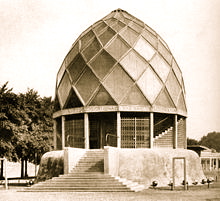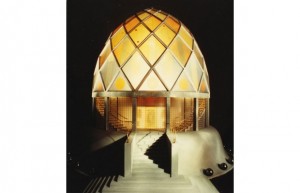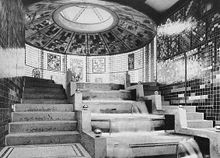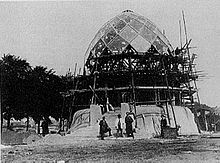#26. Glas Pavilion

 Glas Pavilion Location: Cologne, Germany Architect: Bruno Taut Year: 1914 (Temporary Structure)
Glas Pavilion Location: Cologne, Germany Architect: Bruno Taut Year: 1914 (Temporary Structure)
The Glass Pavilion was an experiment in testing the potential of glass in architectural practice. Achieved as a monument, rather than a functional structure, at the Cologne Deutscher Werkbund Exhibition of 1914, Taut’s most famous building allowed the architect to express his belief that glass could be the material on which to build a spiritual utopia. That might sound as insane as building with glass, and Taut achieved nothing else if not driving the notion in the minds of architectural historians.
1914 “Glass Pavilion” of Bruno Taut
The Glass Pavilion, built in 1914 and designed by Bruno Taut, was a prismatic glassdome structure at the Cologne Deutscher Werkbund Exhibition. The structure was a brightly colored landmark of the exhibition, and was constructed using concrete and glass. The concrete structure had inlaid colored glass plates on the facade that acted as mirrors. Taut described his little temple of beauty as
| “…reflections of light whose colors began at the base with a dark blue and rose up through moss green and golden yellow to culminate at the top in a luminous pale yellow.” |
Taut’s Glass Pavilion is his best known single building achievement. He built it for the association of the German glass industry specifically for the 1914 exhibition. They financed the structure that was considered a house of art. The purpose of the building was to demonstrate the potential of different types of glass for architecture. It also indicated how the material might be used to orchestrate human emotions and assist in the construction of a spiritual utopia. The structure was made at the time when expressionism was most fashionable in Germany, and it is sometimes referred to as an expressionist-style building. The only known photographs of the building were made during 1914; due to their black and white nature, these photographs are only marginal representations of the actualities of the work. The building was destroyed soon after the exhibition since it was an exhibition building only and not built for practical use.
The Glass Pavilion was a pineapple-shaped multi-faceted polygonal designed rhombic structure. It had a fourteen-sided base constructed of thick glass bricks used for the exterior walls devoid of rectangles.Each part of the cupola was designed to recall the complex geometry of nature. The Pavilion structure was on a concrete plinth, the entrance reached by two flights of steps (one on either side of the building), which gave the pavilion a temple-like quality. Taut’s Glass Pavilion was the first building of glass bricks of importance.
 Interior staircases and waterfalls
Interior staircases and waterfalls
There were glass-treaded metal staircases inside that led to the upper projection room that showed a kaleidoscope of colors. Between the staircases was a seven-tiered cascading waterfall with underwater lighting, this created a sensation of descending to the lower level ‘as if through sparkling water.’ The interior had prisms producing colored rays from the outside sunlight. The floor-to-ceiling colored glass walls were mosaic. All this had the effect of a large crystal producing a large variety of colors.
The frieze of the Glass Pavilion was written with aphoristic poems of glass done by the anarcho-socialist writer Paul Scheerbart. Scheerbart’s ideas also inspired the ritualistic composition of the interior. For Scheerbart, bringing in the moon’s and the stars’ light brought in different positive feelings which led to a whole new culture.
Examples of these were
| “Colored glass destroys hatred.” |
| “Without a glass palace, life is a conviction.” |
 “Glass Pavillion” of Taut being built.
“Glass Pavillion” of Taut being built.
Paul Scheerbart in 1914 published a book called Glasarchitektur (“Architecture in glass”) and dedicated it to Taut. Taut in 1914 founded a magazine called Frühlicht (“Dawn’s Light”) for his Expressionist devotees. It emphasized the iconography of glass which is also represented by his Glass Pavilion. This philosophy can be traced back to accounts of Solomon’s Temple. An early drawing of the Glass Pavilion by Taut says he made it in the spirit of a Gothic cathedral.


